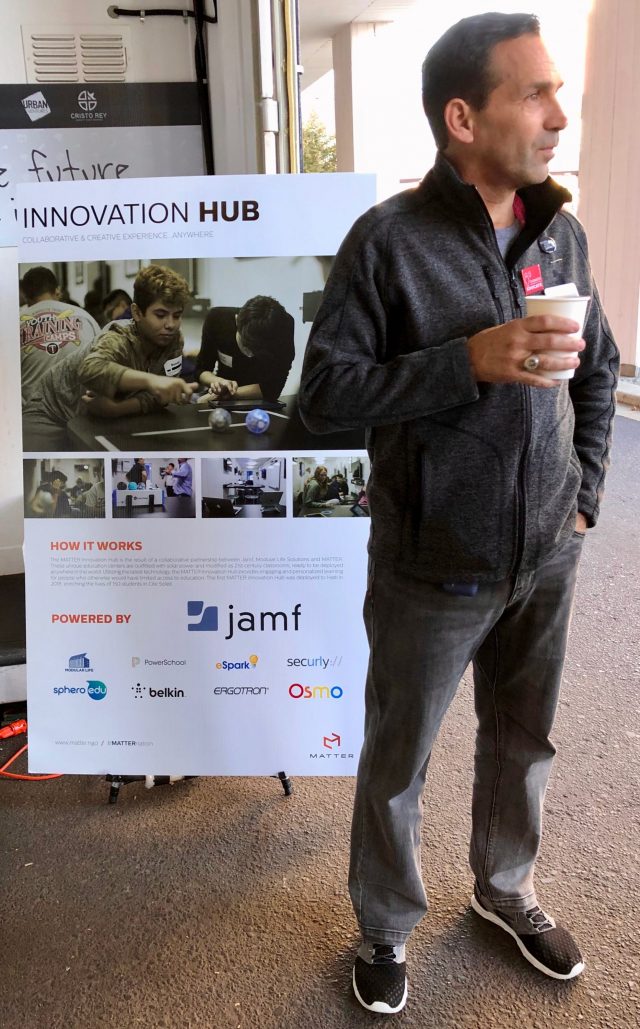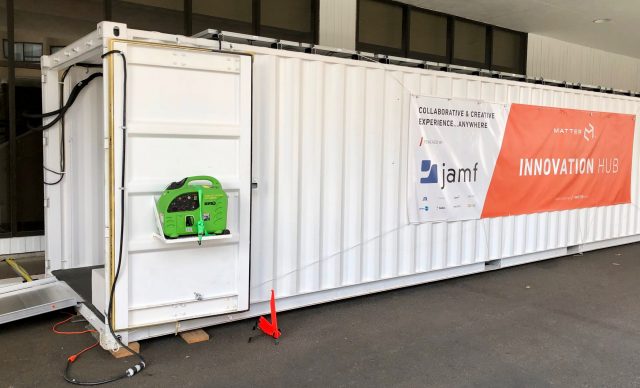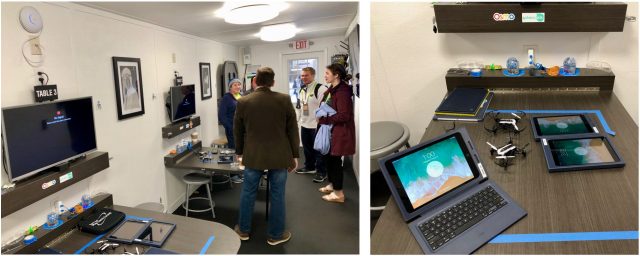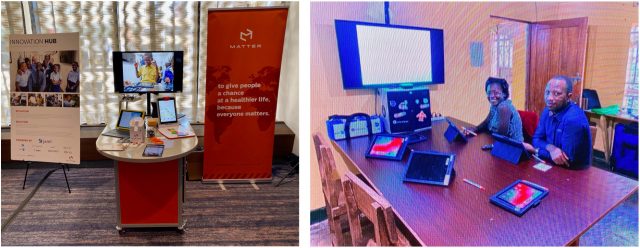Jamf and the Matter Innovation Hub
The most interesting and unusual discussions I had at the recent Jamf Nation User Conference didn’t revolve around IBM’s research into its employee choice program (see “IBM Finds Its Mac Users to Be More Productive Than PC Users,” 12 November 2019), or even how a company called Locus Health is leveraging iPads to enable remote monitoring and care for patients after they leave the hospital.

Instead, I was fascinated with the sessions by—and conversations I had with—Jamf’s Global Education Strategist, Dave Saltmarsh. A constructivist teacher by training, Saltmarsh has over 25 years of experience integrating technology into education and managing school instructional and information technology. As you might guess, he wasn’t focusing on uses of Jamf’s device management software, which is heavily used by educational institutions, but instead on the education itself. And, interestingly, education in developing countries.
That’s because, in August 2017, Jamf began an outreach program to bring educational technology to a school in Haiti. That initial project—now called an Innovation Center—supplied the school with hardware and software. Subsequent trips by Jamf employees taking advantage of the company-provided “Volunteer Time Off” resulted in the installation of Internet access, additional hardware, and teacher training in what Saltmarsh calls Technology-Enabled Active Learning.
With an eye toward systematizing and simplifying the task of bringing education technology to developing-world schools, in 2018, Jamf partnered with Modular Life Solutions to encapsulate a tech-infused classroom in a standard shipping container that would be durable and easy to move. The result, the Innovation Hub pod, was a tour de force of design and technology, all powered (in the tropics, anyway) by solar panels on the roof.

Inside, tables that students could sit around lined the walls, with each station outfitted with a screen connected to an Apple TV. Each student got an iPad (well protected by a Logitech Rugged Combo 2 case) to work with, and could display what they were doing on the shared screen via AirPlay. The stations were also equipped with tiny drones and Sphero SPRK+ robotic balls for the kids to program and control.

To be clear, the Innovation Hub is a collaborative project, not something that Jamf did on its own. Jamf has provided some funding, donated its software, helped raise additional money, and solicited hardware donations. But the company realized from the very beginning that it didn’t make sense to get into this field alone, so it partnered with Matter, a global non-profit that promotes education, healthcare service, and healthy lifestyles in developing nations. In turn, Matter coordinates with other non-profits on the ground in various countries to deliver the Innovation Hub pods.
Installations
The first Innovation Hub pod went to Haiti in October 2018, near the school where Jamf had first provided technology in August 2017. In May 2019, the second pod went to Zimbabwe.
Around that point, the team realized that as useful as the shipping container pods were, they were also expensive and slow to build and ship—the one destined for Zimbabwe got stuck on the docks in Mozambique for three months because the country was devastated by back-to-back hundred-year hurricanes.
For a more agile approach, Jamf and Matter developed an even smaller installation, which they call an Innovation Station, which is a single long table, around which five or six students can cluster. It still has an Apple TV and screen for shared display, and an iPad for each of the kids, and Jamf is still training the teachers in Technology-Enabled Active Learning.

Somewhat organically, Jamf and Matter ended up with three different approaches: the initial Innovation Center, which is a full-sized classroom for 20–25 kids, the Innovation Hub shipping container pod, and the single-table Innovation Station. What they realized was that the Innovation Hub pod could be an advance party of sorts—starting in a school district with few resources but an active and enthused administration. Once it had proved its worth, the hope is that the populace will be able to come together to build a permanent Innovation Center, allowing the pod to move on to another district. In fact, that’s happening with the pod in Zimbabwe, and it’s about to move to a nearby school. The same goes for the Innovation Station—it’s small and inexpensive enough to serve as a proof-of-concept, after which it can hopefully be replaced by a larger Innovation Center.
To continue the chronology, in July 2019, Jamf and Matter set up an Innovation Station in Senegal (funded in part by the Senegalese basketball player Gorgui Dieng, who plays for the Minnesota Timberwolves) and in August 2019, another Innovation Station in Uganda. Finally, thanks in part to support from the First Lady of Zimbabwe, they’re currently installing a full-fledged Innovation Center in a school in the capital of Zimbabwe that has 1000 students.
That all adds up to two each of the Innovation Hub pods, the small Innovation Stations, and the larger Innovation Centers. Up to this point—not including the Innovation Center in Zimbabwe that’s just starting—these installations have helped educate over 1100 students and employ a number of adults as teachers. One of them has even become certified in the Apple Teacher program, making him one of the few people so certified in Zimbabwe.
Ponderings
While thinking about what Jamf has done here, I’m struck by how almost diametrically opposed the Innovation Hub initiative is from the overall focus of the company. That’s not a bad thing, of course. Still, I find it interesting that Jamf, a Minneapolis-based company with over 1000 employees that focuses on technology management for large enterprises, has put so much effort into a small and not obviously scalable project that supports education in developing countries. Perhaps it’s a case of balance—a project that makes such a difference in the lives of specific kids set against the day-to-day work of building highly scalable software that helps IT admins manage millions of Apple devices.
I suggested to Dave Saltmarsh that perhaps the technology—the iPads, the Apple TV, the robotic balls—was acting as a sort of Trojan Horse, making the Innovation Hub concept more compelling to funders and policymakers while the real win was in improving educational approaches. He was conflicted on that since he agreed that just changing the furniture in some of these developing countries would make a huge difference, while that wouldn’t be enough in the United States, where he hopes the Innovation Hub project may someday have an effect as well.
Plus, he said, the key is that the technology enables certain kinds of teaching. The class as a whole can be given some independence within a few approved iPad apps while the teacher works with one or two students individually. But when the teacher needs to get the attention of the entire class—or even just some students who have gone off task—a touch on a button freezes the iPads so the kids are forced to re-engage. In other words, it’s not about teaching technology itself—something that’s fraught with issues, given the speed with which tech changes—but using the technology as a teaching tool. In fact, it’s in the name of Saltmarsh’s approach: Technology-Enabled Active Learning. Active learning doesn’t require technology but can be enhanced with its use.
In the end, the Innovation Hub project is almost entirely positive. It may not have scaled hugely in its first few years, but I think the hope is that it will experience a snowball effect. Support from the very top of the government in Zimbabwe, for instance, could provide significantly increased resources and funding, which could radically increase the number of schools using Technology-Enabled Active Learning and the number of students benefiting from it. Success in one country might even spill over into others. That’s all well off in the future, of course, but every oak tree starts as an acorn.
If you’re intrigued by the Innovation Hub project and want to support it financially or through your organization, check out the partner section of the Matter Innovation Hub Web page, which also provides additional details.
Thank you for posting this interesting and thoughtful article. I can see applications for this approach and technology in remote, isolated communities in northern Canada.
Glad you liked it—it was definitely off the beaten path for TidBITS articles, but it was such an interesting thing to run into at the Jamf Nation User Conference that I couldn’t resist. I meant to write about it last year (hence some of the 2018 photos) but lost track of it afterward. So I was happy I could return to the topic this year.
Adam,
The problem of remote and poor communities has been in my mind lately as I have been editing a paper on the well-being of First Nations communities in Canada. The paper has not yet been released but one of the sources was this presentation, Remoteness of First Nations Communities <http://www.csls.ca/events/cea2018/thoppil.pdf>. I sent the link to your article on to Tom Flanagan, the author of the piece I’m editing.
Regards,
Lindsey Martin
Sounds like the Innovation Hub could be a boon for education in the First Nations. I’d encourage you (or someone else in your world) to reach out to Matter and see what might come of it. It’s largely about funding, so if there could be a grant, things could become possible…
What is a constructivist teacher?
It’s a school of thought about how to teach:
https://saskschoolboards.ca/wp-content/uploads/97-07.htm
Thanks, Adam. Sounds to me, a retired teacher, like old wine in a new bottle.
Very possibly, or perhaps just a way of putting effective teaching techniques into a bucket so they can be explained in a single useful way to those who are non-experts.
I hear that there are now 14 Matter Innovation Hubs, with several in Zimbabwe. Matter recently wrote about Jamf CEO Dean Hager and how an Innovation Hub in Zimbabwe is making a difference.
Other articles from Matter’s blog also focus on the Innovation Hubs.